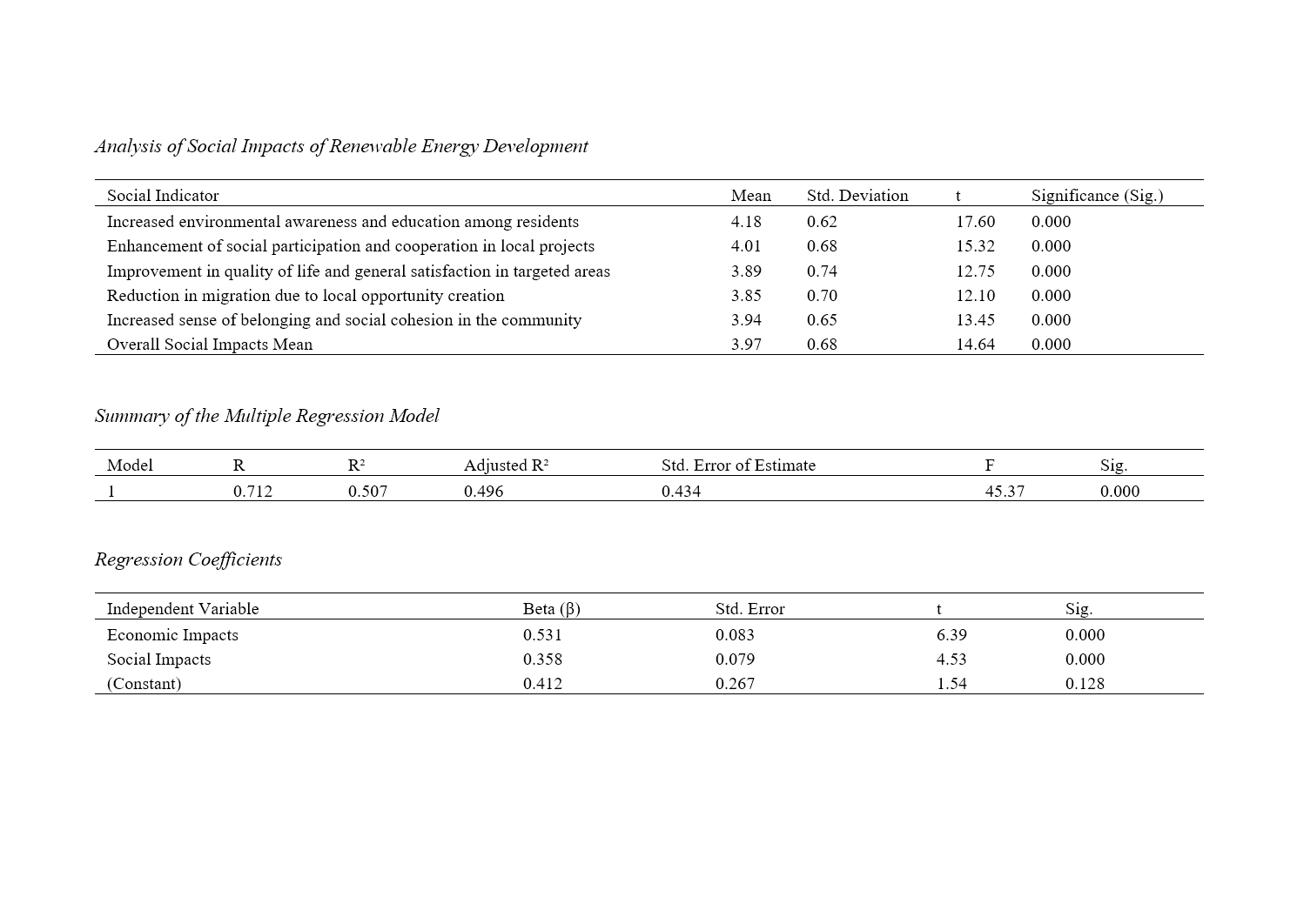Examining the Social and Economic Impacts of Renewable Energy Development on Local Communities and Related Businesses
Keywords:
Renewable energy, economic impacts, social impacts, local businesses, sustainable developmentAbstract
The development of renewable energy, as one of the key components in achieving sustainable development, has multiple implications for the social and economic dimensions of local communities and related businesses. The purpose of the present study is to examine the economic and social impacts of renewable energy development on local communities and entrepreneurs active in this sector. This study was conducted using a descriptive-analytical method with a quantitative approach. The statistical population consisted of 150 experts and entrepreneurs in the renewable energy sector in selected provinces of the country. Data were collected using a researcher-made questionnaire and analyzed using SPSS software. The results indicated that the development of renewable energy has a significant impact on improving economic indicators. Specifically, the average effect of employment increase was calculated as 4.12, energy cost reduction as 3.89, and regional investment growth as 4.03 (on a scale of 1 to 5). From a social perspective, the average of indicators such as increased local participation was 4.20, strengthened sense of social belonging 4.05, and overall public satisfaction 4.10. Pearson correlation analysis also revealed a positive and significant relationship between economic and social impacts (r = 0.691, p < 0.01). These findings suggest that the expansion of renewable energy can simultaneously lead to regional economic growth and enhancement of social capital in local communities. The research findings demonstrate that renewable energy development significantly increases job opportunities, reduces energy costs for small and medium-sized enterprises, and stimulates regional investments. From a social standpoint, the results indicate improvements in social capital, increased local participation, and enhanced quality of life in regions utilizing renewable energy. Overall, the results indicate that the expansion of clean energy holds significant potential for enhancing economic and social sustainability at the local community level and for developing innovative businesses.
References
Deilami Azodi, A., Khodadad Hosseini, S. H., Kordnaeij, A., & Meshbaki Esfahani, A. (2020). Conceptualization and explanation of the adaptation model of the business model in the information and communication technology industry. Business Strategies, 33(17), 77-106. https://cs.shahed.ac.ir/article_2451.html?lang=en
Farahti, M., Salimi, L., & Gholizadeh Arat Bani, M. (2024). Financing Renewable Energy Projects: A Case Study of Selected Developing Countries. Iranian Journal of Energy Economics. https://doi.org/10.22054/jiee.2024.76012.2042
Hassan, Q., Viktor, P., Al-Musawi, T. J., Ali, B. M., Algburi, S., Alzoubi, H. M., Khudhair Al-Jiboory, A., Zuhair Sameen, A., Salman, H. M., & Jaszczur, M. (2024). The renewable energy role in the global energy transformations. Renewable Energy Focus, 48, 100545. https://doi.org/10.1016/j.ref.2024.100545
IEA. (2022). Renewables 2022: Analysis and forecast to 2027. International Energy Agency. https://link.springer.com/article/10.3103/S0003701X23600704
Ji, C. Y., Tan, Z. K., Chen, B. J., Zhou, D. C., & Qian, W. Y. (2024). The impact of environmental policies on renewable energy investment decisions in the power supply chain. Energy Policy, 186, 113987. https://doi.org/10.1016/j.enpol.2024.113987
Jouali, Y. (2024). The Consumption of Renewable Energy as a Clean and Sustainable Alternative and Its Impact on Economic Growth in the MENA Region. Journal of Infrastructure Policy and Development, 8(8), 6247. https://doi.org/10.24294/jipd.v8i8.6247
Khalili, S., Lopez, G., & Breyer, C. (2025). Role and trends of flexibility options in 100% renewable energy system analyses towards the Power-to-X Economy. Renewable and Sustainable Energy Reviews, 212, 115383.
Liu, Y., Yao, S., Xiao, S., & Gu, X. (2018). Review of status developments of high-efficiency crystalline silicon solar cells. J. Phys. D: Appl. Phys, 51(12). https://doi.org/10.1088/1361-6463/aaac6d
Mobini Dehkordi, A., & Torkaman, J. (2020). Analytical comparison of business networks and business ecosystems. Strategic Studies in the Oil and Energy Industry (Human Resource Management in the Oil Industry), 11(44), 3-32. https://iieshrm.ir/article-1-896-fa.html
Nasiri, F. (2021). Analysis of the economic effects of wind energy on local businesses in Khorasan Razavi province. Journal of economics and regional development, 11(2), 55-70. https://ue.ui.ac.ir/article_29269.html
Opoku, E. E. O., Acheampong, A. O., Dogah, K. E., & Koomson, I. (2024). Energy innovation investment and renewable energy in OECD countries. Energy Strategy Reviews, 54, 101462. https://doi.org/10.1016/j.esr.2024.101462
Pieroni, M., McAloone, T., & Pigosso, D. (2019). Business model innovation for circular economy and sustainability: A review of approaches. Journal of Cleaner Production, 198-216. https://doi.org/10.1016/j.jclepro.2019.01.036
Raeisi, A., & Ahmadvand, A. M. (2018). Dynamic analysis of the development of solar energy use in Iran. 1st National Conference of the Iranian System Dynamics Association, Tehran.
Ramezani Khouzestani, M., & Reza Nazabadi, M. (2018). Explaining the necessity of developing renewable energies in Iran with emphasis on solar energy. 6th Iranian Conference on Renewable Energies and Distributed Generation, Tabriz.
Rezaei, M., Taheri Azadeh, D., & Davoudi, H. (2022). Examining the social effects of the development of solar power plants on rural communities in Kerman province. Environmental Sciences Journal, 24(3), 87-103. https://iranthinktanks.com
Rezvani, M., & Abedi, S. (2020). The role of new energies in empowering local communities: A case study of Tabas city. Quarterly Journal of Planning and Spatial Armature, 25(1), 119-135. https://ensani.ir/fa/article
Rostami, S., Anousheh, M., Darvishi Satlani, F., Keshavarz Turk, A., & Mohammadi Hosseini, B. (2024). Identifying drivers of entrepreneurship development in renewable energy: Providing a structural interpretive model with a foresight approach. Environmental Education and Sustainable Development Journal, 13(1), 119-134.
Simas, M., & Pacca, S. (2020). Socio-economic benefits of wind power in Brazil: Local community perspectives. Energy Policy, 146. https://doi.org/10.1016/j.enpol.2020.111749
Sovacool, B. K., Sivarajah, U., Irani, Z., Gupta, S., & Mahroof, K. (2021). The socio-economic impacts of renewable energy: A review of the literature Role of big data and social media analytics for business to business sustainability: A participatory web context. Renewable and Sustainable Energy Reviews, 141, 163-179. https://doi.org/10.1016/j.rser.2021.110791 10.1016/j.indmarman.2019.04.005
Statista. (2024). Share in the total final energy consumption of renewable energy in Iran from 2014 to 2029. https://www.statista.com/forecasts/1151277/renewable-energy-share-forecast-in-iran
Wanniarachchi, T., Dissanayake, K., & Downs, C. (2020). Improving sustainability and encouraging innovation in traditional craft sectors: the case of the Sri Lankan handloom industry. Research Journal of Textile and Apparel, 24(2), 111-130DO - 110.1108/RJTA-1109-2019-0041. https://www.emerald.com/insight/content/doi/10.1108/RJTA-09-2019-0041/full/html
Xie, Y., & Lin, B. (2025). Financial leasing and China’s renewable energy firms' investment behavior: In the context of government subsidy reduction. Renewable and Sustainable Energy Reviews, 214, 115547.
Xu, G., Yang, M., Li, S., Jiang, M., & Rehman, H. (2024). Evaluating the effect of renewable energy investment on renewable energy development in China with panel threshold model. Energy Policy, 187, 114029. https://doi.org/10.1016/j.enpol.2024.114029
Zanganeh, M., Aghajeri, E., & Forozanfar, M. (2021). Implementation of a smart algorithm based on fuzzy logic for energy resource management of a power generation system including solar energy and a storage source using Arduino boards. Quarterly Journal of Intelligent Methods in the Electricity Industry, 13(49). https://www.sid.ir/paper/1034561/en
Zgurskyy, M. (2024, 2024). Renewable Energy Technologies: Progress and Future Directions. https://answerthis.io/blog/renewable-energy-technologies-progress-and-future-directions
Zhang, Y., Ren, J., Pu, Y., & Wang, P. (2020). Solar energy potential assessment: A framework to integrate geographic, technological, and economic indices for a potential analysis. Renewable Energy, 149, 577-586. https://doi.org/10.1016/j.renene.2019.12.071
Zhang, Y., Zheng, K., Xia, F., & Cheng, Z. (2024). Fintech, natural resource rents, renewable energy consumption and environmental quality: A perspective of green economic recovery from BRICS economies. Resources Policy, 89, 104604. https://doi.org/10.1016/j.resourpol.2023.104604
Zhaoa, F., Chena, X., Yia, Z., Qina, F., Tanga, Y., Yaoa, W., Zhoua, Z., & Yougen. (2020). Study on the solar energy absorption of hybrid solar cells with trapezoidpyramidal structure based PEDOT: PSS/c-Ge. 359, 277-386. https://www.sciencedirect.com/science/article/pii/S0038092X20305211

Downloads
Published
Submitted
Revised
Accepted
Issue
Section
License
Copyright (c) 2024 Zana Ghaderi

This work is licensed under a Creative Commons Attribution-NonCommercial 4.0 International License.









